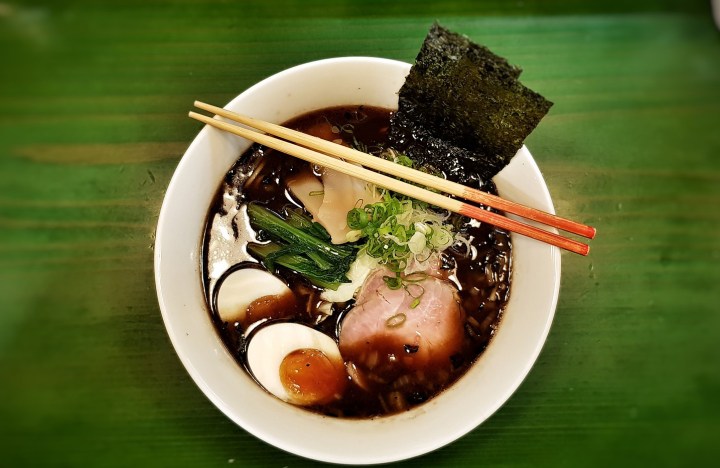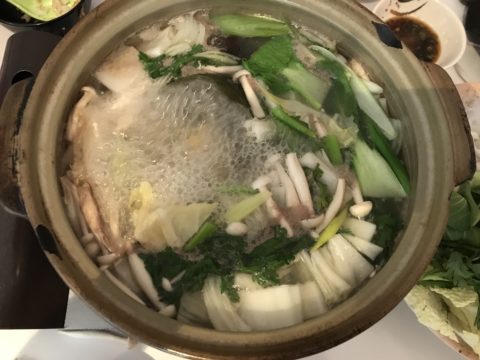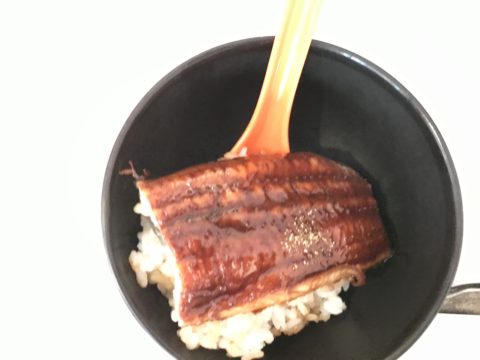JAPANESE JOZI
The Land of the Rising Sun in the City of Gold – it’s not just about sushi

I’m sitting somewhere behind ex-president Nelson Mandela’s left ear, a floor up from the palio-shaped ‘square’. I am also determined to eat only the Japanese dishes on the menu.
The writer supports Nosh Food Rescue, an NGO that helps Jozi feeding schemes with food “rescued” from the food chain. Please support them here.
Now we’re specially not talking sushi today. All these Japanese places do sushi too, of course, but in South Africa it’s almost become a cuisine on its own. Sushi is consumed locally and plentifully without regard for any Japanese association. These places are very much about Japanese food and association.
Since 1995 Jozi Japanese food has meant Yamato and vice versa. It particularly meant home from home to actual Japanese visitors and residents. At present these are in short supply what with Covid-19 international travel restrictions.
Before it moved to Yamato’s present address in Oxford Road’s Illovo Muse, the less pretty, more stark original stood not far away. Japanese businessmen, hardly ever businesswomen then, would eat in large bespectacled groups, wearing dark suits and sharing dishes on the table. Cristina Sato was often in evidence at her parents’ and then her brother’s famous restaurant.
She owns, chefs and runs the newer incarnation of Yamato, providing the classic Japanese dishes in all their variety and idiosyncrasy. A huge spray of cherry blossoms or sakura decorates one wall and there’s a glass prep kitchen to show off the sushi chef’s skills for those who want it. Interestingly, her sister has a sushi-mostly restaurant, Japa in Rivonia. Cristina herself is in soft pink with pastel-camo booties.
4,1 km away is a very different, one-month-old, designer-new restaurant serving contemporary Japanese izikaya inspired or even tapas style dishes. It’s called Tang and also serves Hong Kong Cantonese dishes. The menu intertwines both.
Run by ever-tanned A-lister Nicky van der Walt, this is the luxurious version of the Asian experience. Nicky’s a damn good businessman and has also even done his restaurants, the Primi Piatti franchise and then a top tenner of the time, Circle in Greenside, among others. Now he’s also launching his own wine and a new company all at once.
Here heavy pots of Japanese cherry blossoms are interspersed with champagne displays. Everyone wears black, even the better-heeled patrons.
Shabu shabu to bento boxes
Cristina at Yamato teases me about having long been such a fan of shabu-shabu for so long. It’s true. I think it does epitomise more traditional Japanese food in all its subtleties, food-sharing and how considered real Japanese presentation is, always.

A taster from Cristina’s original home area of Hokkaido, of chashu ramen. (Photo: Marie-Lais Emond)
Before I have another reminder dip at the shabu shabu, Cristina serves me a little taster from her original home area of Hokkaido, of chashu ramen, thin pork neck slices, slow-cooked for two days in Cristina’s intense, reduced bone broth with noodles.
On the table with it is gyoza. You see, that’s the thing with Japanese cuisine. It’s inclusive of its history so it includes Chinese rice, chopsticks, soy and even some of their dishes like jiaozi, potstickers, named and made subtly differently in Japan by quick-frying them first before their steaming. These gyoza are melt-in-your mouth sensations also with pork pieces and shredded Japanese “pointed” cabbage. They are huge sellers.
We discuss the borrowed food elements in Japan and Cristina reminds me that tempura is a Portuguese introduction, from the time in the middle of the last century when Portuguese people traded and some settled in the south of Japan. She hurries to the kitchen to get a few freshly tempura’d examples. That’s interesting too because nothing is made in this kitchen until it’s ordered except for the long, slow food. This tempura looks like gossamer, although it is lightly crisp. The idea, says Cristina, is that the seaweed, vegetables or prawns or whatever should be visible through the tempura.
Shabu shabu is like an ever-developing fondue but was not borrowed from the Swiss. When it starts, there’s simply a pot of simmering salted water with a good hunk of kombu seaweed in it. Alongside is a carefully ordered and beautiful heap of very fresh vegetables like leeks and spring onion, homemade tofu, chrysanthemum greens, bok choy, enoke and shiitake mushrooms. They are gradually added to make up the broth in which very thin slices of rib-eye, arranged in a gorgeous glass bowl, are wrapped around your chopsticks, swirled quickly in the stock to cook and eaten. The name comes from the sound of chopsticks swishing through the stock.

The name shabu shabu comes from the sound of chopsticks swishing through stock. (Photo: Marie-Lais Emond)
It takes ages to eat your way through everything and that is part of the charming process, for, gradually the meat starts adding its own juices to the stock, along with the other ingredients. Finally as the stock reduces, it is quite thick and coats the swished meat differently. Any of the other elements can be fished out with chopsticks and eaten too.

Gradually the meat starts adding its own juices to the stock, along with the other ingredients. (Photo: Marie-Lais Emond)
There are always a couple of sauces to dip the beef into, usually a ponzu-citrusy-soy sauce and a sesame-mirin-dashi type sauce. There’s usually too much for even two people and three would be great for all that beautiful beef. By the way, I manage to try some eel on rice while swishing shabu shabu beef. It’s another favourite of mine.

I manage to try some eel on rice. (Photo: Marie-Lais Emond)
What is soon to be another of my major favourites, however, is the Bento Box, or boxes really, since they come in a lot of combinations, a new one for every day. They are ideal of course to have delivered from Yamato through Uber Eats these days. But they have, not surprisingly I suppose because of the fun they are, become a really popular menu item too. I hear a group of local men, seemingly all friends who eat out here, ordering them at their table, among other things like those gyozas.
All the compartments are filled with delicious items, eel might well be included in one. You work your way around the box, as if having a succession of courses, special sauces and pickled accompaniments or oshinka on the way. Then you finish in the middle, with the equivalent of dessert or cheese, which is engagingly and savourily pickled radish. Sake is a good idea to sip throughout this process, not cold.
There is a right way of having the lacquered box in front of you, with the rice at the bottom left, for some mythical reason she can’t remember Cristina giggles.
We only discuss dessert. Japanese meals usually have a complete mix of protein and carbohydrates, a panoply of colours (green, red, yellow, white and purple or black) and flavours (bitter, sour, hot, salty, delicate and including sweet), so that it is respected as being completely healthy. It also means that people don’t need a dessert although Westerners often like it and Japanese people have developed tastes for things like ice cream, bread and coffee over the last thirty years. I know there’s a lovely green matcha ice cream on the menu and that Yamato’s coffee is excellent.
Yaki-nuki and the chocolate explosion
From the moment of entering Tang you do wonder whether you’ve shined your shoes or rather what they cost. However, the staff are very well-trained (for nearly three months before the doors opened), knowledgeable and very hospitable. There is a lot of service.
I’m sitting somewhere behind ex-president Nelson Mandela’s left ear, a floor up from the palio-shaped “square”. I am determined to eat only the Japanese dishes on the menu. While determining, the first taste of Tang that passes my lips is a Shiso truffle oyster. It’s appropriate I realise. This is, as Nicky van der Walt has said, unashamedly luxurious. It doesn’t necessarily cater for the Japanese customer but gives him or her and many others the more contemporary tastes of Japan, beautifully presented but also beautifully prepared to please travel-refined palates.
Chef Vixa Kalenga explains the detailing, of which there is great care taken throughout. The shiso leaf for instance is quite a respected culinary herb in Japan for adding a slight bit of mint but more of a citrusy edge to raw fish, like oyster. Almost a kind of sashimi, except I’m steering clear of sushi in particular.
Tuna tataki is my next taste and the utterly stunning emerald plate is pounded tuna swimming in a ponzu featuring the taste of yuzu, a flavour and fruit I love and one that crops up quite often here. It also has very finely chopped sweet onion in it.

Tuna tataki is swimming in a ponzu featuring the taste of yuzu. (Photo: Marie-Lais Emond)
Across the page I see some examples of gyoza. I’m still in the izikayo section of the menu and perhaps that’s where I should stay. My eyes roll down over some Cantonese dishes and stop at yaki-nuki. Yaki is contact grilling as in teriyaki. But I just like the whole hyphenated word. The nuki part, I think in a rather silly way, might mean it’s very thoroughly nuked on the grill. Of course, it doesn’t. Actually it seems to mean without the grill. The food in question is short rib and is, when I see it, utterly perfectly slow-cooked or maybe done sous vide, before receiving a sticky coating and a bowl of light ponzu-style mayo for dipping, the latter according to the chef.
It’s quite a big piece for tapas or a bar-snack, I reckon but is so right for our South African tastes and expectations while being in keeping with the Japanese theme. It’s the perfect food for the wealthier market.
Under the signature dishes is black cod with miso. Irresistible and again perfect. How does chef Vixa get it so right every time? The skin is crisp and yes miso-tasting with that savoury-caramelly-salty taste. But is the dem miso sauce the one made famous by Nobu Matsuhisa, just spelled slightly differently? This one, anyway, has pale miso, sake and mirin in it.

Is the ‘dem’ miso sauce the one made famous by Nobu Matsuhisa (called black cod den miso)? (Photo: Marie-Lais Emond)
The caramelly idea has taken hold and I’m presented “although slightly outside of your Japanese theme” with a dessert of salted caramel and chocolate fondant with black sesame. The dessert has printed on it the Tang logo in gold. It is tasteful and grand, very much what Tang is as a restaurant.
‘Although slightly outside of your Japanese theme,’ a dessert of salted caramel and chocolate fondant with black sesame. (Photo: Marie-Lais Emond)
Alongside a quenelle of tonka bean ice cream, the fondant bursts volcano-like, pouring forth Tang’s richness and loveliness. DM/TGIFood
Yamato Illovo Muse, 198 Oxford Rd, Illovo
Tang Shop No 120, Nelson Mandela Square, Sandton





 Become an Insider
Become an Insider
Comments - Please login in order to comment.